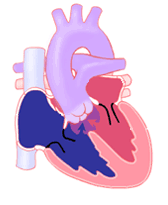The normal function of a heart includes two main blood vessels leaving the heart: the aorta carrying blood to the body and the pulmonary artery that delivers blood to each lung.
In patients with truncus arteriosus there is only one great blood vessel or trunk leaving the heart, which then feeds the blood vessels that go to the lungs and the body.
A patient with truncus arteriosus usually begins to have problems in the first week of life. Their oxygen levels are usually lower than normal.
Because of the excessive amount of blood flow to the lungs with this malformation, congestive heart failure develops very quickly. With an X-ray, the heart looks enlarged and the lungs look hazy.
Indications of congestive heart failure included rapid breathing, shortness of breath, wheezing, grunting or very noisy breathing, nasal flaring, and restlessness.
The liver may be enlarged; neck vein distention, poor feeding, and facial swelling are also seen.
While truncus arteriosus may be suspected, an echocardiogram will confirm the presence of the disorder.Initial treatment begins with stabilizing the patient. Medications to control congestive heart failure such as diuretics are often started.
The use of a feeding tube or intravenous feeding may be needed. Surgical correction is typically carried out in the first few weeks of life after the infant is stabilized and the surgical repair of truncus arteriosus requires the use of heart-lung bypass machine.
Currently over 90 percent of patients survive repair of truncus arteriosus. As the patient grows, they will need to be followed by their cardiologist.
